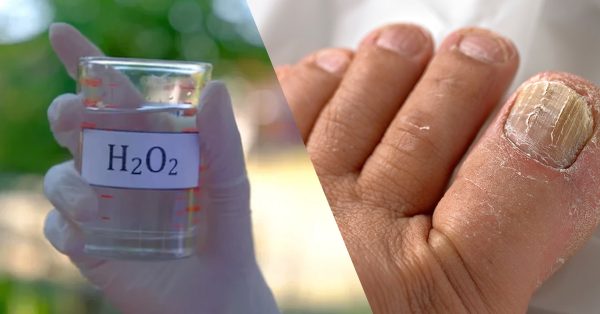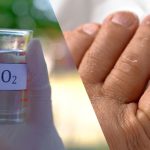Did you know that hydrogen peroxide, a common household item, can effectively combat toenail fungus? This simple solution boasts antifungal properties that can help tackle the stubborn infection. When used consistently and correctly, hydrogen peroxide has shown promising results in eliminating toenail fungus.
By understanding the proper application method and frequency, you can harness the power of this readily available remedy to address your fungal concerns. Say goodbye to the discomfort and embarrassment caused by toenail fungus with this accessible and potentially effective treatment option.
Quick Summary
Hydrogen peroxide may take several weeks to effectively kill toenail fungus, with the daily application being crucial for success.
Understanding Toenail Fungus
Causes
Toenail fungus, medically known as onychomycosis, is typically caused by exposure to warm and moist environments. This condition often arises from fungi like dermatophytes infiltrating the nails through small cuts or separations from the nail bed. Poor hygiene habits and wearing tight shoes can also contribute to its development.
Symptoms
Yellowing, thickening, and brittleness of toenails are common symptoms of a fungal infection. Individuals may experience nail discoloration, foul odor, and even pain or discomfort while walking. If left untreated, the infection can spread to other nails or lead to more severe complications.
Treatment Options
- Over-the-counter antifungal creams: These creams contain ingredients like clotrimazole or terbinafine that help combat the fungal infection.
- Prescription oral medications: In severe cases, doctors may prescribe oral antifungal drugs such as fluconazole or itraconazole for more aggressive treatment.
- Topical treatments: Nail lacquers like ciclopirox are applied directly to the affected nails to target the fungus.
- Laser therapy: This innovative treatment involves using laser technology to eradicate the fungus effectively.
Hydrogen Peroxide Basics
Chemical Properties
Hydrogen peroxide, a pale blue liquid, consists of two hydrogen and two oxygen atoms. It acts as an oxidizing agent when applied to toenail fungus. The chemical formula for hydrogen peroxide is H2O2.
When hydrogen peroxide comes into contact with the infected area, it releases oxygen that helps eliminate the fungal infection. This process occurs due to the oxidation reaction triggered by hydrogen peroxide.
The efficacy of hydrogen peroxide in treating toenail fungus lies in its ability to penetrate the nail bed and reach the affected area. Its antifungal properties work by breaking down the fungal cell walls, ultimately eradicating the infection.
Safety Measures
Before using hydrogen peroxide for toenail fungus treatment, it is crucial to conduct a patch test to check for any allergic reactions. Dilute the hydrogen peroxide with water to reduce its potency and prevent skin irritation.
To ensure safety during application, use protective gloves to shield your hands from direct contact with undiluted hydrogen peroxide. Properly ventilate the area where you are applying hydrogen peroxide to avoid inhaling fumes.
Always store hydrogen peroxide in a cool, dark place away from sunlight to maintain its effectiveness. Keep it out of reach of children and pets to prevent accidental ingestion or exposure.
Hydrogen Peroxide for Toenail Fungus
Effectiveness
Hydrogen peroxide can be effective in killing toenail fungus due to its antifungal properties. It works by eliminating the fungus that causes nail infections. When applied correctly, it can help reduce fungal growth and promote healing.
To increase effectiveness, ensure the hydrogen peroxide concentration is appropriate. A concentration of around 3% is commonly used for treating toenail fungus. It’s important to be consistent with applications to see positive results over time.
Application Methods
When using hydrogen peroxide for toenail fungus, begin by cleaning the affected area thoroughly. Then, soak a cotton ball in hydrogen peroxide, applying it directly to the infected nail. Allow the solution to sit on the nail for a few minutes, ensuring it penetrates the affected area.
For best results, repeat this process twice daily. Consider combining hydrogen peroxide treatment with other antifungal agents or natural remedies for enhanced efficacy. Remember to be patient as it may take several weeks to notice significant improvements in the condition of the infected nail.
✅ Do You Have Toe Nail Fungus? Try This Tonight (Watch This)
Duration for Results
Initial Effects
Hydrogen peroxide starts working immediately upon application to the affected toenail. It penetrates the nail and attacks the fungus directly, leading to quick relief from symptoms.
The affected area may experience a tingling sensation, indicating that the hydrogen peroxide is actively combating the fungus. This initial reaction shows that the treatment is beginning to take effect.
Complete Clearance
For complete clearance of toenail fungus using hydrogen peroxide, it typically takes several weeks to months. The exact duration varies based on the severity of the infection and consistency of treatment.
To achieve optimal results, it’s crucial to apply hydrogen peroxide regularly as directed. Consistent treatment will ensure that the fungus is thoroughly eradicated, leading to complete clearance over time.
Factors Influencing Treatment Time
Fungus Severity
The severity of the toenail fungus plays a crucial role in determining how long hydrogen peroxide treatment will take. For mild cases, where the infection is localized and not widespread, the treatment duration may be shorter. In contrast, severe infections that have spread extensively may require a longer treatment period.
When dealing with mild fungal infections, hydrogen peroxide can effectively target the affected area and eliminate the fungus more rapidly. However, severe cases that have penetrated deeper layers of the nail may necessitate prolonged treatment to completely eradicate the infection.
Application Frequency
The frequency of applying hydrogen peroxide also impacts the treatment time for toenail fungus. Regular and consistent application of hydrogen peroxide as directed can expedite the healing process. On the other hand, irregular application or missing doses may prolong the treatment duration.
To achieve optimal results, it is recommended to apply hydrogen peroxide consistently according to the prescribed schedule. This ensures that the fungus is continuously exposed to the antifungal properties of hydrogen peroxide, aiding in its eradication.
Individual Health
Individual health factors such as immune system strength and overall health condition can influence how quickly hydrogen peroxide eliminates toenail fungus. People with compromised immune systems may experience a longer treatment time due to reduced ability to fight off infections.
Moreover, underlying health conditions or medications that weaken the immune system can impact the effectiveness of hydrogen peroxide treatment. Maintaining good overall health through proper nutrition and lifestyle habits can support faster healing from toenail fungus infections.
Step-by-Step Application Guide
Preparation
To effectively use hydrogen peroxide for toenail fungus, start by gathering the necessary supplies: hydrogen peroxide, cotton balls, and a small basin. Ensure your feet are clean and dry before beginning the application process. Additionally, trim your nails to remove any excess debris or overgrown areas.
Application Process
Soak a cotton ball in hydrogen peroxide and apply it directly to the affected toenail. Make sure to cover the entire nail surface and the surrounding skin. Allow the hydrogen peroxide to sit on the nail for about 10-15 minutes. Repeat this process twice daily for optimal results.
- Pros of using hydrogen peroxide:
- Effective in killing fungus on the toenail.
- Easy to apply at home without professional assistance.
Post-Application Care
After applying hydrogen peroxide, thoroughly rinse off your feet with warm water and dry them completely. Avoid wearing shoes or socks that may cause excessive moisture, as fungi thrive in damp environments. Monitor the progress of your treatment regularly and be patient, as it may take several weeks to see significant improvement.
✅ Doctor: If you Have Nail Fungus, Do This Immediately (Watch This)
Potential Side Effects
Common Reactions
Some individuals may experience skin irritation such as redness or burning sensation after applying hydrogen peroxide. It is crucial to monitor for any signs of allergic reactions.
In some cases, hydrogen peroxide can cause dryness and peeling of the skin, especially around the affected toenail area. This can lead to discomfort and sensitivity.
When to Seek Help
If you notice severe redness, swelling, or blistering, it is advisable to stop using hydrogen peroxide immediately. Seek medical attention if the symptoms persist or worsen.
Persistent itching or a rash developing around the toenail area could indicate a more serious reaction. Consult a healthcare professional for further evaluation and guidance.
Alternative Remedies
Natural Options
Tea Tree Oil: This natural remedy has antifungal properties that can help combat toenail fungus. Apply tea tree oil directly to the affected nail daily.
Apple Cider Vinegar: Soak your feet in a mixture of water and apple cider vinegar to create an environment inhospitable to the fungus.
Coconut Oil: Known for its moisturizing properties, coconut oil can also be effective against toenail fungus when applied regularly.
Over-the-counter Products
Antifungal Creams: These creams are readily available at pharmacies and can be applied directly to the infected nail.
Antifungal Nail Polishes: These products work by creating a protective barrier over the nail, preventing further fungal growth.
Antifungal Sprays: Easy to use and convenient, antifungal sprays can effectively treat toenail fungus.
Final Remarks
In your quest to tackle toenail fungus, hydrogen peroxide emerges as a promising contender. Its antifungal properties offer a natural and accessible solution worth exploring. Understanding the treatment duration and influencing factors equips you with the knowledge to navigate this remedy effectively. Remember, consistency in application is key to witnessing results. Be mindful of potential side effects and consider alternative remedies if needed. Your journey to healthier nails starts with informed decisions and proactive steps.
Take charge of your toenail health today by incorporating hydrogen peroxide into your routine. Stay informed, stay consistent, and embrace the path to fungus-free feet!



